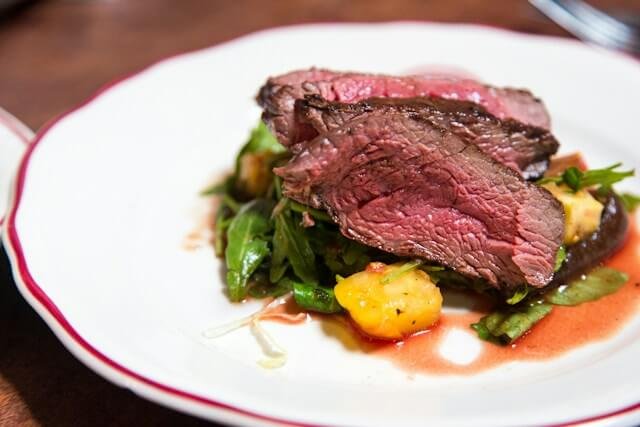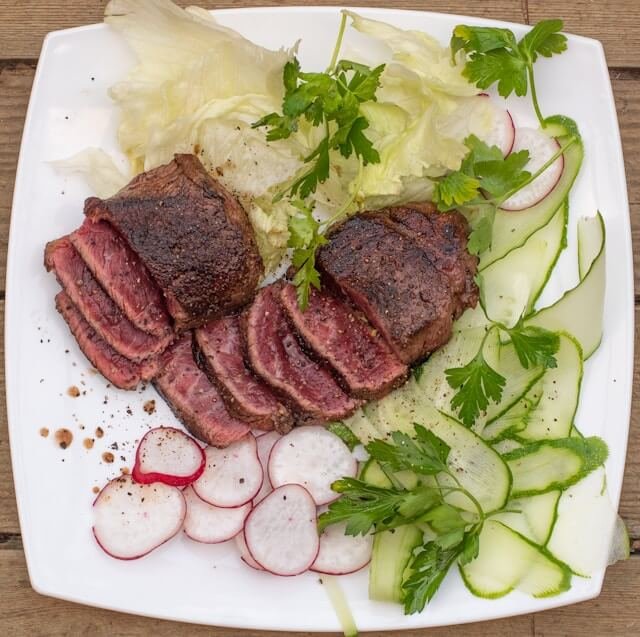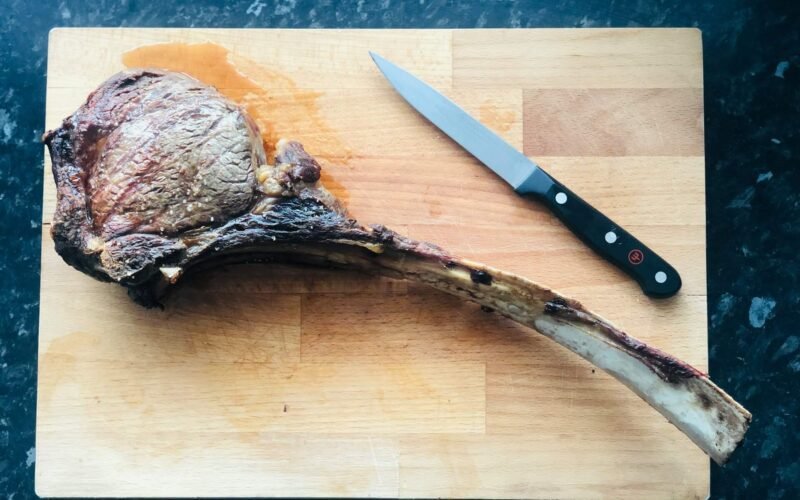Table of Contents
ToggleExotic Meats for the Personal Chef
The world of gourmet cuisine is continually expanding and reinventing itself, and one of the most exciting trends is the use of wild game exotic meats. For aspiring personal chefs looking to make a mark with their unique creations, incorporating these rare meats can set you apart in the culinary landscape. From the untamed flavor profiles to the healthy and sustainable ethos, there is much to learn and explore in this emerging domain.
Aspiring personal chefs need to offer something different than traditional chefs who specialize in one or two kinds of cuisines. I’ve written an extensive article with links to many cuisines for your consideration – World Cuisine for Personal Chefs
Understanding Wild Game Exotic Meats
Wild game meats are a category of proteins that venture beyond the usual beef, chicken, and pork found in most home kitchens. They encompass a vast array of animals that are hunted in their natural habitats or raised in carefully controlled environments, including venison, bison, pheasant, and rabbit. The allure of working with these meats lies in their individual characters—each carrying a unique blend of flavors and textures, drastically different from the farm-to-table meats we’re accustomed to.

Types and Flavors
Wild game offers a plethora of profiles that range from rich and robust (bison) to delicate and nuanced (pheasant). These flavors are a direct result of the animals’ diets, lifestyles, and habitats. The leanness of wild game meats often leads to a deeper, more intense taste, as well as a firm, largely unmarbled texture. This characteristic has implications for cooking techniques, as the meats often require different handling and preparation to achieve their delicious potential.

Sourcing and Procurement
For personal chefs, sourcing wild game meats can be an adventure in itself. It’s crucial to establish relationships with reputable suppliers who prioritize quality, ethical hunting practices, and the well-being of wild animal populations. Hunting organizations, farmers who specialize in exotic meats, and certain markets or specialty stores can be excellent starting points for procurement.
Selecting High-Quality Suppliers
When choosing a supplier, inquire about their sourcing methods and whether they adhere to regulations that promote wildlife conservation and ethical treatment. Look for recommendations within culinary circles and stress the importance of freshness and proper handling to ensure the meat arrives in the best possible condition.

Preparation and Cooking Techniques
Wild game meats are not your typical protein—they require a different approach to preparing and cooking to maximize their flavors and retain their health benefits. These meats are leaner, which means they can dry out more easily if overcooked. Marination is often recommended to tenderize and enhance taste.
Wondering what tools a personal chef might need? I’ve written an extensive article for you – A Comprehensive List Of Must-Have Tools and Essential Items for the Personal Chef
Cooking Best Practices
When handling wild game, it’s essential to use gentle cooking methods. For example, searing and then finishing in the oven, or slow-cooking with moisture, can be ideal for maintaining juiciness. Mind the internal temperature, as it makes a world of difference between stringy and succulent. A meat thermometer is your best friend when working with wild game meats.
Flavor Pairing and Recipes
Exploring the world of wild game can lead to some truly innovative and memorable dishes. To complement the distinct flavors of these exotic meats, pairing them with the right ingredients is essential. Earthy elements like mushrooms, fresh herbs, and a variety of grains often match well with wild game meats.

Unique and Delicious Recipes
Crafting a robust venison stew, preparing succulent alligator tail skewers, or perfectly roasting a leg of rabbit provide just a glimpse into the culinary possibilities with wild game. Complex sauces, such as a red wine reduction or juniper berry-infused demi-glace, can elevate the flavors even further. These complex dishes are sure to impress discerning palates and adventurous eaters alike.
Health and Sustainability Benefits
Wild game meats are often touted for their health benefits, being lower in fat and higher in protein and beneficial micronutrients. They are also free of antibiotics and hormones commonly found in farm-raised meats. Additionally, when sourced responsibly, wild game meats embody a sustainable and eco-friendly source of protein.
Nutritional and Environmental Aspects
Venison, for instance, is a leaner alternative to beef and is a great source of iron and vitamin B. By embracing wild game, personal chefs are advocating for conservation and can even help control wildlife numbers in regions where certain species might become overpopulated. It’s a narrative that adds depth and meaning to the dishes you create and serve.

Exploring the Exotic: A Guide to America’s Growing Appetite for Exotic Meats
As American diners increasingly seek new culinary adventures, exotic meats are becoming a popular choice. From the southern kitchens where beef and wild game share the spotlight, to the fine-dining establishments experimenting with unusual offerings, these unique proteins are reshaping the American palate. Here’s a guide to seven exotic meats that are now more commonly available in the U.S., yet still remain a mystery to many.
1. Alligator
A staple in Louisiana’s Cajun cuisine, alligator meat has a mild flavor and firm texture similar to chicken or pork. It can be grilled, fried, or used in stews and gumbos. A traditional preparation involves marinating the meat in a blend of cayenne pepper, garlic, and lemon juice before frying it to golden perfection.
2. Jellyfish
While not a conventional choice, jellyfish is gaining popularity due to its unique texture. Often served in salads or appetizers, it’s usually marinated in a mixture of soy sauce, sesame oil, and vinegar to enhance its delicate, slightly salty flavor.
3. Ostrich
This lean, red meat is often compared to beef but with a slightly sweeter taste. Ostrich steaks can be grilled or pan-seared, and they pair well with bold spices like rosemary and thyme.
4. Rattlesnake
For the truly adventurous, rattlesnake offers a delicate, slightly sweet flavor. It’s often smoked or made into a hearty stew. A Southwestern style preparation might involve roasting the snake over an open fire, then serving it with a spicy chili sauce.
5. Wild Boar
Described as having a strong, nutty, and rich flavor, wild boar is a versatile meat that can be roasted, grilled, or used in stews. Traditional preparations often involve slow-cooking the meat with a blend of herbs and spices to bring out its robust taste.
6. Guinea Pig
Although it might raise eyebrows, guinea pig is a delicacy in many parts of the world. The meat is tender and tastes similar to rabbit. It is traditionally roasted whole and served with a spicy aji sauce2.
7. Kangaroo
Kangaroo meat is lean and rich in flavor, with a taste reminiscent of venison. It can be grilled, roasted, or used in stews. Australian-style preparations often involve marinating the meat in a mixture of red wine, garlic, and rosemary before grilling2.
Here is a list of 13 more exotic meats along with some traditional or popular preparations for each:
- Camel: Used in slow-cooked dishes like stews and tagines.
- Emu: Often cooked as steaks, burgers or sausages on the grill.
- Antelope: Usually grilled or roasted, it’s lean and often compared to venison.
- Bison: Made into steaks, burgers or roasts; it has a rich, slightly sweet flavor.
- Venison (Deer): Often pan-seared as steaks or slow-cooked in stews.
- Elk: Marinated and grilled, or used in sausages and jerky.
- Duck: Roasted whole or pan-seared as breasts with a variety of sauces.
- Goat: Slow-cooked in curries, stews, or barbecued in various cuisines worldwide.
- Crocodile: Often grilled or fried; it’s said to taste like a cross between chicken and crab.
- Zebra: Usually grilled as steaks or used in stews; it’s lean and slightly sweet.
- Rabbit: Often stewed or braised with wine, herbs, and vegetables.
- Horse: Popular in some European and Asian cuisines, it’s often served as steaks or in sausages.
- Frog Legs: Typically breaded and fried, or grilled with garlic and herbs.
Remember, sourcing and consuming these meats should be done responsibly and ethically, considering factors such as sustainability and animal welfare.
Exotic Meats for the Personal Chef
Embracing wild game exotic meats presents personal chefs with a world of opportunities—both in terms of taste and values. With the demand for unique dining experiences on the rise, the versatility that these meats offer is a tool for creativity and differentiation. As you build your culinary repertoire, consider the adventure that wild game meats can bring to your kitchen. Whether enhancing a menu or crafting a signature dish, these exotic meats challenge you to think outside the conventional, ensuring your creations stand out and leave a lasting impression.
For those aspiring to make a name in the culinary world, the addition of wild game can be a turning point. It’s not just about the novelty; it’s about engaging in an ethical and health-conscious approach to cooking. By being mindful of sourcing, skilled in preparation, and creative in presentation, personal chefs can truly make a mark with wild game exotic meats. So, go forth and discover the delights waiting to be unleashed in the wild spaces of the culinary realm. Your clients and your own taste buds will thank you.
Here are some of my favorite tools for providing my personal chef service
As an experienced personal chef, I’ve found that the secret to creating mouthwatering dishes goes beyond just having a passion for food. It’s also about using the right kitchen tools. Today, I’m going to share with you my must-have kitchen items that help me bring my culinary creations to life.
1. Chef’s Knife
The first item on my list is a high-quality chef’s knife. It’s the most versatile tool in my kitchen, perfect for chopping, slicing, and dicing. My preference is for a Global Chef’s Knife, known for the edge and the way they are balanced.
2. Cast Iron Skillet
Next up is a good old cast-iron skillet. From searing steaks to baking cornbread, this pan does it all. I love the Lodge Cast Iron Skillet, which retains heat beautifully and adds a nice crust to anything you cook.
3. Stainless Steel Pots and Pans
A set of stainless steel pots and pans is essential for a variety of cooking techniques. They’re great for simmering, boiling, and sautéing. All-Clad’s Stainless Steel Cookware Set is my go-to choice for its exceptional performance and durability.
4. Immersion Blender
An immersion blender makes pureeing soups, making smoothies, and blending sauces a breeze. I suggest the Braun Multiquick Hand Blender, which is powerful, easy-to-clean, and highly versatile.
5. Digital Thermometer
To ensure perfectly cooked meats every time, a digital thermometer is a must. The ThermoPro TP19 Waterproof Digital Meat Thermometer provides speedy and accurate readings, ensuring your roast chicken or prime rib is cooked to perfection.
6. Silicone Spatula
A silicone spatula is a chef’s best friend for its versatility. It’s heat-resistant, non-stick, and perfect for everything from folding batter to stirring sauces. I recommend the OXO Good Grips Silicone Spatula.
7. Stand Mixer
Lastly, for avid bakers, a stand mixer is a game-changer. The KitchenAid Artisan Series 5-Qt. Stand Mixer isn’t just a pretty face; it makes mixing doughs and batters effortless.
These are the tools that I use daily in my personal chef service. Remember, quality tools make a difference, but they don’t have to break the bank. Start with the basics and add on as you grow more comfortable and adventurous in the kitchen.
Happy cooking!

